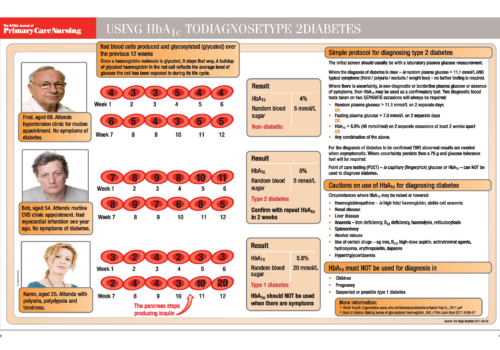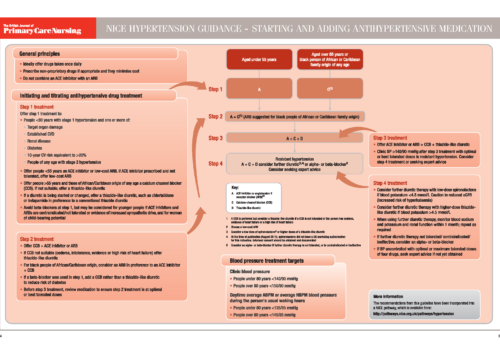As the use of insulin therapy becomes more common in the ever-growing population of people with diabetes, practice nurses need to be aware of the range of insulins now available and how they work as they take on more responsibility for the management of these patients. In this article, we look at the production and role of insulin in the body and how type 1 and type 2 diabetes affects this. Moving on to newer insulins, we review how longer-acting insulins are used to mimic the characteristics of natural background insulin, the role of shorteracting insulins available for mealtime bolus doses, and the use of insulin mixtures in practice.
Post-MI patients: the no tears review
This second article focuses on safe and effective prescribing of medications which will reduce risk of further cardiovascular events. This series provides a ‘hands on’ practical guide to conducting medication reviews of long-term cardiovascular conditions. In this issue, we look at how to ensure post-myocardial infarction patients are taking the right medications at the right doses to ensure they get maximum benefit.
How to carry out an annual review for patients at high CVD risk
Putting Prevention First, the national strategy for cardiovascular risk assessment for people aged 40 to 74 years, remains high on the healthcare agenda regardless of NHS changes. The “Cog Man” on the cover of the guidance and leaflets distributed to practices and pharmacies highlights the close links between the heart, brain, kidneys and diabetes and underlines the comprehensive nature of vascular risk assessment. In this article, we look at how to carry out an annual review in high-risk people with a cardiovascular risk score of 20% or higher but who do not have high blood pressure, diabetes, chronic kidney disease or atrial fibrillation.
Caring for patients with anaemia of chronic disease
Many patients presenting in general practice will, at some time, complain of tiredness and lack of energy. Investigations to discover the cause are often conducted and will usually include blood tests such as a full blood count to see if anaemia is to blame. Patients may assume that all anaemia is iron deficiency anaemia but there are, of course, different types of anaemia. Interpreting investigations correctly and acting on them appropriately can ensure that the patient gets the right diagnosis and appropriate treatment.
Physical activity: getting people moving to prevent CVD
If physical activity could be taken as a tablet, the dramatic benefits it achieves in reducing cardiovascular disease and diabetes as well as many other conditions mean all of us would be on it. But many people currently miss out because it takes more effort to increase physical activity than popping open a tablet bottle. This article sets out the evidence for physical inactivity as a major cardiovascular risk factor and how to put the evidence into practice and get patients moving.
Back to Basics: Using HbA1c to diagnose type 2 diabetes
Guest editorial
There is a Danish proverb that states ‘Better to ask twice than lose your way once’. Unfortunately however, in my opinion, people living with diabetes – especially those with type 2 diabetes – do not question their healthcare professionals enough about what they can expect from living with the condition. This is especially true in the area of hypoglycaemia – or low blood sugar.1 We often attribute diabetes with high blood sugar, but many people don’t appreciate the potential dangers of letting their blood sugar get too low.
Achieving target blood pressure: Fixed-dose combination therapy
High blood pressure is undoubtedly the major modifiable risk factor for cardiovascular disease (CVD). However, despite advances in management, it remains inadequately managed. Across Europe, only about one in four of treated patients achieve guideline-recommended targets for blood pressure. This has important consequences for increasing the risk of CVD, kidney disease, microvascular disease, as well […]
Towards the rational prescribing of oral contraceptives (UPDATED JANUARY 2012)
This supplement was originally published in 2011 and has since been updated and peer-reviewed in January 2012.
Back to Basics: NICE hypertension guidance – starting and adding antihypertensive medication
Making sense of salt and cardiovascular risk
While salt is an essential part of a healthy diet excessive salt intake is now an important focus for reducing the risk of cardiovascular disease in the UK. It is estimated that reducing everyone’s salt intake to the equivalent of one teaspoon per day would prevent 23,000 deaths from stroke and heart attack each year. Here are practical ideas for helping to achive this goal.
Taking the weight: a primary care team approach to obesity management
Most of the UK population – including the patients we see every day – are now more likely to have a weight problem than be of a healthy weight. Instead of focusing our efforts, and valuable resources, on managing the consequences of obesity, we should tackle its causes and appropriately manage patients motivated to address their unhealthy weight.

























